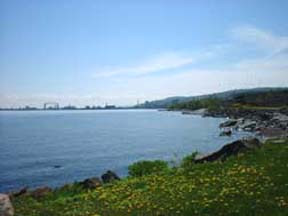Home
Syllabus
E-mail Class
E-mail Craig
Resources
Journal
Discussion
Assignments
Schedule
January
February
March
April
May
|
Glocalization Project
Understanding the Key Idea
To understand this project, you should also read the entry for "Glocalization"
from the Ideas site and follow its links to see
examples of the use of this concept on the Web.
Choosing a Topic
In this project, you will create a Web site that focuses on some "glocalizable" aspect of Duluth, Lake Superior, The Northshore or some locale in Minnesota.
Far from cluttering the World Wide Web with excessively "local"
concerns, each of your projects will develop a set of Web pages covering
some specific, local site, product, phenomenon, or historical topic for
an audience who will never physically visit the area.
aspect of Duluth, Lake Superior, The Northshore or some locale in Minnesota.
Far from cluttering the World Wide Web with excessively "local"
concerns, each of your projects will develop a set of Web pages covering
some specific, local site, product, phenomenon, or historical topic for
an audience who will never physically visit the area.
Defining an Audience and their Interests
Why would audiences beyond Minnesota, the Upper Midwest, or even the
US borders find any value in a Web site focusing on a local area topic?
In fact, localness has new relevance, even as the forces of globalization
create what one critic has called "McWorld." For instance, chrysanthemum
enthusiasts are no longer limited to participation in local or regional
gatherings, or the occasional national convention. Thanks to the reach
of the media, most recently the Web, such enthusiasts are able to "visit"
a huge variety of local Chrysanthemum sites all across the world, both
famous and obscure, and communicate with fellow enthusiasts in a "panlocal,"
rather than generically "global," chrysanthemum culture—what
we might call a "chrysanthemumscape." Your site should speak
to a similarly conceived scape (as defined
on the Ideas site's "glocalization"
page).
Imagining the Form and Content
- Depending on your topic and glocal audience, your site will either
advance an argument or tell a story—perhaps both simultaneously.
- Since you are designing a Web site, you will develop this argument
or narrative not simply in a linear verbal text, but through a combination
of words, images, and linked pages (hypertext) that recognizes the more
autonomous role played by the user or visitor to the site than that
played by the reader of a conventional print-culture document.
- While you want to design in a style appropriate to this more user-oriented
medium, you still want to use the attributes of the medium to get across
your agenda (your argument/story).
- The best of these sites will also give the audience a means to participate
in this "scape," and reasons to return to the site in the
future.
- Since you are local, you should take maximum advantage of your access
to develop original materials for your site, including your own text,
photographs, and research.
- You should decide, depending on what's appropriate to your topic and
audience, if you want to design your site in a corporate, civic or personal
"voice." Be consistent, however.
- Take care not to emulate the less sophisticated kinds of Web pages
that don't really use the medium fully, but only imitate print discourse,
such as the "Future
Birthplace of Captain James T. Kirk" site from Riverside, Iowa,
which is really just a print article placed on the Web.
Looking at Examples
As we've seen in our review of the term "glocalization,"
there is a growing consciousness that the local and global can be reconciled,
either by customizing (localizing) global topics or products for various
audiences/markets, or by publicizing a locale to the world as a symbol,
case study, point of origin, "flavor," brand or a commodifiable,
"authentic" experience. Indeed, the attraction of the Internet
isn't just to escape into the Wide World, but to experience, in some remotely
mediated way, the flavor of other locales, cultures and situated individual--a
flavor that is somehow already significant to us.
- The Mary
Tyler Moore Show tour of Minneapolis makes these local spots visitable
to the many fans of the 70s-era show, which is still seen on TV Land
network.
- Triple Cycle Theory chronicles
the history of the Seattle music scene which spawned bands like Nirvana,
Hole, Mudhoney, Pearl Jam, and Soundgarden. Click the link on the home
page for "history."
- Tabasco
uses the exotic locale and history of its original home on Avery Island
to market its hot sauce.
- The New York City nightclub CBGB
promotes its (arguable) reputation as the birthplace of punk.
- The LBJ and Lincoln
home sites offer history or Americana buffs a chance to experience the
landscapes and cultures that shaped these presidents.
- Numerous sites offer virtual tours meant to provide educational value,
such as the Cedar
River Watershed Virtual Tour in Seattle, WA, or the Plimoth
Plantation Tour in Plymouth, MA.
Be sure to read the entry for "Glocalization"
from the Ideas site if you haven't already!
|